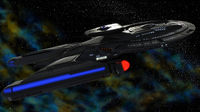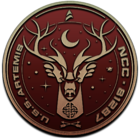Artemis Specs
| USS Artemis-A | ||
|---|---|---|
 ACTIVE STATUS | ||
| ||
The Luna Class
The Luna-cass starship was designed by Dr. Xin Ra-Havreii, of Utopia Planitia Fleet Yards on Mars, and initially conceived for scientific exploration of the Gamma Quadrant following the discovery of the Bajoran Wormhole. The project was sidelined by the impending threat from the Dominion, then restarted following the end of the Dominion War. Luna-class starships were the top of the line in Starfleet's scientific and exploratory pursuits on behalf of the United Federation of Planets.
The ship features a sensor pod just above the back of the saucer section that can be accessed via turbolift. It has more advanced sensor nets and data collection grids that were better than even the most advanced space telescope employed by the Federation for its time. The sensor pod itself could be manned by up to 8 crewman at a time, and even included a special TOV suit that allowed a person to control and manipulate probes, giving them a "front row seat" to the action as it were. One of the features of the Luna-class was the highly adaptable life support systems in place throughout the ship, including unprecedented customisation of crew quarters. This allowed the crew roster to include a far greater diversity than most Starfleet vessels, whose life support systems usually mean ships were crewed dominantly by one race only.
The USS Artemis-A
The USS Artemis, NCC-81287, is a Luna class starship named after the Greek moon goddess of hunting, wild nature, and chastity.
She was originally launched in 2392 as the USS Doyle and named after Scottish physician and writer Sir Arthur Conan Doyle (1859-1930) and one of New Scotland's moons. She was rechristened the USS Artemis when she was relaunched in 2400.
Similar to other Luna-class vessels, the USS Artemis was designed with the latest scientific technology in mind, to serve in several capacities:
- As a vessel that can engage in long-term scientific exploration far from Federation space
- As a vessel that can pursue first-contact and diplomatic relationships as representatives of the Federation
- As a vessel that can unilaterally engage in intelligence and reconnaissance missions with unaccompanied support
Specifications
- Name: USS Artemis (referred to informally as the "USS Artemis-A")
- Registry: NCC-81287
- Class: Luna
- Classification: Explorer/Reconnaissance Science Vessel
Dimensions
- Length: 454 Meters
- Beam: 204 Meters
- Height: 80 Meters
- Decks: 18 (including sensor pod, 1 deck)
- Mass: 1,400,000 Metric Tons
- Cargo Capacity: 24,000 Metric Tons
Crew Complement
- Total: 350
- Officers: 90
- Enlisted: 260
- Evacuation Capacity: 4,000
- Families: Permitted with permission
- Civilians: Permitted with permission
- Civilian contingent variable, but generally mission-specific and low
Engineering Specifications
Main engineering spans three levels, between Decks 14-16, as does the warp core, though the majority of the work is conducted on Deck 15. While the core itself also spans several decks, access to the core from decks 14 and 16 is restricted.
Also located on deck 15 are the Chief Engineer’s Office, offices and meeting rooms for engineering personnel, labs, and workshops. Two wholly enclosed and reinforced test bays near the forward part of the compartment serve as safe rooms for the testing of experimental or unknown tech as needed.
- Primary Warp Core: Class XV OR-300 Mark V Warp Drive
- Normal Cruising Speed: Warp 8
- Maximum Cruising Speed: Warp 10
- Maximum Top Speed: Warp 12 (12 Hours)
- Impulse Fusion Reactors: 2 FIG-6 Subatomic Unified Energy Impulse Units
- Primary Navigation System: RAV/ISHAK Mod 7 Warp Celestial Guidance
- Computer System: Class XX Bioneural/Isolinear Computer Core - LCARS
- Hull Duration: 80 Years
- Re-Supply Cycle: 1 Year
- Refit Cycle: 2 Years (Minor) - 20 Years (Major)
Tactical Specifications
- Beam Weapons: 8 Type X phaser arrays for a total of 38,500 TerraWatts
- Torpedoes: 4 Pulse-firing Quantum Torpedo tubes (2 fore, 2 aft)
- Torpedo Payload: 150 Quantum Torpedos
- Shields: Auto-Regenerative Adaptive Shield Matrix, total output: 4,500,000 TeraJoules
- Hull: Duranium microfoam and Tritanium plating double hull, plus 6 centimeters of ablative hull armor
Deck 8 houses the office of the Chief of Security, as well as offices for the security/tactical, the armory, phaser range, intelligence suites, and the brig/detention facilities. Additional rooms serve as areas for additional security/tactical or intelligence personnel as well as offices and briefing rooms for day to day security/tactical operations.
Brig/Detention Facilities: The Luna class starship brig is a restricted area that may only be accessed through the security department.There are seven cells built for double occupancy with level 10 forcefield emitters built into each doorway.
Main Armory: Restricted access room located on deck 8 under constant guard. This room contains a maintenance area and multiple sealed weapons lockers. The Luna Class carries enough phasers to arm the entire crew.
Scientific Capabilities and Specs
The Artemis has twenty science labs between decks 9, 11, and 12, in addition to specialized labs located elsewhere throughout the ship.. The labs are designed to be multi-faceted and easily convertible to study various subjects, depending on the needs of the crew and the size of the teams working on the projects. A dedicated astrophysics lab is located on deck 9, and certain labs have been typically dedicated for particular purposes, including Astrophysics, Exobiology, Cybernetics, Geology, and Hazardous Materials.
Several larger labs are heavily reinforced with level 10 containment field emitters and are used for testing and experimentation of unknown technology or hazardous materials/products.
The Sensor Pod is accessible via turbolift. A Sensor Pod is a module that can be connected to the dorsal surface of a starship to extend a starship's sensor capability. The pod lets the ship perform multiple types of scans at the same time including, but not limited to: Antiproton, Autonomic response analysis, Geological scan, High-resolution scan, Passive high-resolution series, Magneton scan, Multiphasic scan, Subspace differential pulse, and Virtual positron imaging scan.
Medical Capabilities and Specs
The Artemis is equipped with a primary Sickbay located on deck 7 and a secondary Sickbay facility on deck 12.
The primary Sickbay contains an ICU, Biohazard Support facility, Radiation Treatment wards, Surgical wards, Null-Gravity Treatment facility, Isolation/Quarantine suites, and Morgue. The Chief Medical Officer’s office is located off main Sickbay, and the Counseling suites are also on the same deck.
The secondary Sickbay facility on deck 12 contains a much smaller facility that is capable of handling emergency surgery and triage response as well as a smaller isolation/quarantine unit.
All Biobeds in both sickbays are equipped with various sensors for monitoring a patient's vital signs. Inside the main surgical suite above the main surgical bed is a large and sophisticated sensor cluster that has been installed on the ceiling to provide advanced scans of a patient to assist the medical care personnel in their duties.
Three medical labs are located just down the corridor from the main sickbay area.
Support vessels
- Shuttlecraft
- 5 type-11
- 2 type-17 heavy cargo
- 2 type-18
- Runabouts
- 1 Danube class
- Other craft
- 1 captain’s skiff
- 6 workbees

